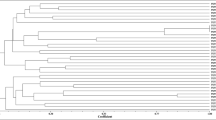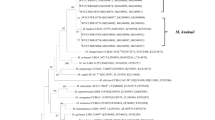Abstract
Within rhizobia, two species nodulating chickpea, Mesorhizobium ciceri and Mesorhizobium mediterraneum, are known as good phosphate solubilizers. For this reason, we have analysed the ability to solubilize phosphate of a wide number of strains isolated from Cicer arietinum growing in several soils in Spain. The aim of this work was to analyse microbial populations nodulating chickpea, that are able to solubilize phosphates, using molecular techniques. In the present work we analyzed 19 strains isolated from effective nodules of C. arietinum growing in three soils from the North of Spain. Nineteen strains showed ability to solubilize phosphate in YED-P medium. These strains were separated into 4 groups according to the results obtained by 879F-RAPD fingerprinting. The 16S rDNA sequencing of a representative strain from each group allowed the identification of strains as belonging to the genus Mesorhizobium. Strains from groups I and II showed a 99.4% and 99.2% similarity with M. mediterraneum UPM-CA142T, respectively. The strains from group III were related to M. tianshanense USDA 3592T at a 99.4% similarity level. Finally, the strain from group IV was related to M. ciceri USDA 3383T with a 99.3% similarity. The LMW RNA profiles confirmed these results. Strains from groups I and II showed an identical LMW RNA profile to that of M. mediterraneum UPM-CA142T; the profile of strains from group III was identical to that of M.␣tianshanense USDA 3592T and the profile of strains from group IV was identical to that of M. ciceri USDA 3383T. Different 879F-RAPD patterns were obtained for strains of the group I, group II and the M.␣mediterraneum type strain (UPM-CA142T). The 879-RAPD patterns obtained for group III also differed from the pattern shown by M. tianshanense USDA 3592T. Finally, the patterns between group IV and M. ciceri USDA 3383T were also different. These results suggest that groups I and II may be subspecies of M. mediterraneum, group III a subspecies of M. tianshanense and group IV a subspecies of M. ciceri. Nevertheless, more studies are needed to establish the taxonomic status of strains isolated in this study.
Similar content being viewed by others
References
Bergersen FJ (1961) The growth of Rhizobium in synthetic media. Aust J Biol Sci 14:349–360
Beringer JE (1974) R factors transfer in Rhizobium leguminosarum. J Gen Microbiol 84:188–198
Bidle KD, Fletcher M (1995) Comparison of free-living and particle-associated bacterial communities in the Chesapake Bay by stable low-molecular-weight RNA analysis. Appl Environ Microbiol 61:944–952
Chen WX, Li GS, Qi YL, Wang ET, Yuan HL, Li JL (1991) Rhizobium huakuii sp. nov. isolated from the root nodules of Astragalus sinicus. Int J Syst Bacteriol 41:275–280
Chen W, Wang E, Wang S, Li Y, Chen X, Li Y (1995) Characteristics of Rhizobium tianshanense sp. nov., a moderately and slowly growing root nodule bacterium isolated from an arid saline environment in Xinjiang, People’s Republic of China. Int J Syst Bacteriol 45:153–159
Chen WM, Laevens S, Lee TM, Coenye T, de Vos P, Mergeay M, Vandamme P (2001) Ralstonia taiwanensis sp. nov., isolated from root nodules of Mimosa species and sputum of a cystic fibrosis patient. Int J Syst Evol Microbiol 51:1729–1735
Cruz-Sánchez JM, Velázquez E, Mateos P, Martínez-Molina E (1997) Enhancement of resolution of low molecular weight RNA profiles by staircase electrophoresis. Electrophoresis 18:1909–1911
de Lajudie P, Willems A, Nick G, Moreira F, Molouba F, Hoste B, Torck U, Neyra M, Collins MD, Lindström K, Dreyfus B, Gillis M (1998) Characterization of tropical tree rhizobia and description of Mesorhizobium plurifarium sp. nov. Int J Syst Bacteriol 48:369–382
de la Puente-Redondo VA, García del Blanco N, Gutiérrez Martín CB, García-Peña FJ, Rodríguez Ferri EF (2000) Comparison of different PCR approaches for typing of Francisella tularensis strains. J Clin Microbiol 38:1016–1022
Fischer-Le Saux M, Viallard V, Brunel B, Normand P, Boemare NE (1999) Polyphasic classification of the genus Photorhabdus and proposal of new taxa: P. luminescens subsp. luminescens subsp. nov., P. luminescens subsp. akhurstii subsp. nov., P. luminescens subsp. laumondii subsp. nov., P. temperata sp. nov., P. temperata subsp. temperata subsp. nov. and P. asymbiotica sp. nov. Int J Syst Bacteriol 49:1645–1656
Haas H, Budowle B, Weiler G (1994) Horizontal polyacrylamide gel electrophoresis for the separation of DNA fragments. Electrophoresis 15:153–158
Halder AK, Mishra AK, Chakrabartty PK (1990) Solubilization of phosphatic compounds by Rhizobium. Indian J Microbiol 30:311–314
Herrera-Cervera JA, Caballero-Mellado J, Laguerre G, Tichy HV, Requena N, Amarger N, Martínez-Romero E, Olivares J, Sanjuán J (1999) At least five rhizobial species nodulate Phaseolus vulgaris in a Spanish soil. FEMS Microbiol Ecol 30:87–97
Höfle MG (1988) Identification of bacteria by low molecular weight RNA profiles: a new chemotaxonomic approach. J Microbiol Methods 8:235–248
Igual JM, Valverde A, Rivas R, Mateos PF, Rodríguez-Barrueco C, Martínez-Molina E, Cervantes E, Velázquez E 2003 Genomic fingerprinting of Frankia strains by PCR-based techniques. Assessment of a primer based on the sequence of 16S rRNA gene of Escherichia coli. Plant Soil 254, 115–123
Jarabo-Lorenzo A, Velázquez E, Pérez-Galdona R, Vega-Hernández MC, Martínez-Molina E, Mateos PF, Vinuesa P, Martínez-Romero E, León-Barrios M (2000) Restriction fragment length polymorphism analysis of PCR-amplified 16S rDNA and low molecular weight RNA profiling in the characterisation of rhizobial isolates from shrubby legumes endemic to the Canary Islands. Syst Appl Microbiol 23:4–18
Jarvis BDW, Pankhurst CE, Patel JJ (1982) Rhizobium loti, a new species of legume root nodule bacteria. Int J Syst Bacteriol 32:378–380
Jarvis BDW, van Berkum P, Chen WX, Nour SM, Fernandez MP, Cleyet-Marel JC, Gillis M (1998) Transfer of Rhizobium loti, Rhizobium huakuii, Rhizobium ciceri, Rhizobium mediterraneum and Rhizobium tianshanense to Mesorhizobium gen. nov. Int J Syst Bacteriol 47:895–898
Jonhson FJ (1990) Detection method of nitrogen (total) in fertilizers. In: Elrich K (ed) Methods of analysis of the Association of Official Analytical Chemists. Association of Official Analytical Chemists, USA pp 17–19
Kimura M 1980. A simple method for estimating evolutionary rates of base substitutions through comparative studies of nucleotide sequences. J Mol Evol 16:111–120
Kumar S, Tamura K, Jakobsen IB, Nei M (2001) Molecular evolutionary genetics analysis software. Arizona State University. Tempe, Arizona. USA
Moulin L, Munive A, Dreyfus B, Boivin-Masson C (2001) Nodulation of legumes by members of β–subclass of Proteobacteria. Nature 411:948–950
Nakamura LK, Roberts MS, Cohan FM (1999) Relationship of Bacillus subtilis clades associated with strains 168 and W23: a proposal for Bacillus subtilis subsp. subtilis subsp. nov. and Bacillus subtilis subsp. spizizenii subsp. nov. Int J Syst Bacteriol 49:1211–1215
Nour SH, Fernández MP, Normand P, Cleyet-Marel JC (1994) Rhizobium ciceri, sp. nov., consisting of strains that nodulate chickpeas (Cicer arietinum L.). Int J Syst Bacteriol 44:511–522
Nour SH, Cleyet-Marel JC, Normand P, Fernandez MP (1995) Genomic heterogeneity of strains nodulating chickpeas (Cicer arietinum L.) and description of Rhizobium mediterraneum sp. nov. Int J Syst Bacteriol 45:640–648
Nuswantara S, Fujie M, Yamada T, Malek W, Inaba M, Kaneko Y, Murooka Y (1999) Phylogenetic position of Mesorhizobium huakuii subsp. rengei, a symbiont of Astragalus sinicus cv. Jpn J Biosci Bioeng 87:49–55
Palomo JL, Velázquez E, Mateos PF, García-Benavides P, Martínez-Molina E (2000) Rapid identification of Clavibacter michiganensis subspecies sepedonicus based on the stable low molecular weight RNA (LMW RNA) profiles. Eur J Plant Pathol 106:789–793
Pearson WR, Lipman DJ (1988) Improved tools for biological sequence comparison. Proc Natl Acad Sci USA 85:2444–2448
Peix A, Rivas-Boyero AA, Mateos PF, Rodríguez-Barrueco C, Martínez-Molina E, Velázquez E. (2001). Growth promotion of chickpea and barley by a phosphate solubilizing strain of Mesorhizobium mediterraneum under growth chamber conditions. Soil Biol Biochem 33:103–110
Perret X, Staehelin C, Broughton WJ (2000) Molecular basis of symbiotic promiscuity. Microbiol Mol Biol Rev 64:180–201
Rivas R, Velázquez E, Valverde A, Mateos PF, Martínez-Molina E (2001) A two primers random amplified polymorphic DNA procedure to obtain polymerase chain reaction fingerprints of bacterial species. Electrophoresis 22:1086–1089
Rivas R, Velázquez E, Palomo JL, Mateos P, García-Benavides P, Martínez-Molina E. (2002a). Rapid identification of Clavibacter michiganensis subspecies sepedonicus using two primers random amplified polymorphic DNA (TP-RAPD) fingerprints. Eur J Plant Pathol 108:179–184
Rivas R, Velázquez E, Willems A, Vizcaíno N, Subba-Rao NS, Mateos PF, Gillis M, Dazzo FB, Martínez-Molina E (2002b) A new species of Devosia that forms a nitrogen-fixing root-nodule symbiosis with the aquatic legume Neptunia natans (L. f.) Druce. Appl Environ Microbiol 68:5217–5222
Saitou N, Nei M (1987) A neighbour-joining method: a new method for reconstructing phylogenetics trees. Mol Biol Evol 44:406–425
Sprinzl M, Moll J, Meissner F, Hatmann T (1985) Compilation of tRNA sequences. Nucleic Acid Res 13:1–49
Sy A, Giraud E, Jourand P, García N, Willems A, de Lajudie P, Prin Y, Neyra M, Gillis M, Boivin-Masson C, Dreyfus B (2001) Methylotrophic Methylobacterium bacteria nodulate and fix nitrogen in symbiosis with legumes. J Bacteriol 183: 214–220
Thompson JD, Gibson TJ, Plewniak F, Jeanmougin F, Higgins DG (1997) The clustalX windows interface: flexible strategies for multiple sequence alignment aided by quality analysis tools. Nucleic Acid Res 24:4876–4882
Velázquez E, Cervantes E, Igual JM, Peix A, Mateos PF, Benamar S, Moiroud A, Wheeler CT, Dawson J, Labeda D, Rodríguez-Barrueco C, Martínez-Molina E (1998a) Analysis of LMW RNA profiles of Frankia strains by staircase electrophoresis. Syst Appl Microbiol 21:539–545
Velázquez E, Cruz-Sánchez JM, Mateos PF, Martínez-Molina E (1998b) Analysis of stable low molecular weight RNA profiles of members of the family Rhizobiaceae. Appl Environ Microbiol 64:1555–1559
Velázquez E, Calvo O, Cervantes E, Mateos PF, Tamame M, Martínez-Molina E (2000) Staircase electrophoresis profiles of stable low molecular weight RNA as yeast fingerprinting. Int J Syst Evol Microbiol 50:917–923
Velázquez E, Igual JM, Willems A, Fernández MP, Muñoz E, Mateos PF, Abril A, Toro N, Normand P, Cervantes E, Gillis M, Martínez-Molina E (2001a) Description of Mesorhizobium chacoense sp. nov. that nodulates Prosopis alba in the Chaco Arido region (Argentina). Int J Syst Evol Microbiol 51:1011–1021
Velázquez E, Martínez-Romero E, Rodríguez-Navarro DN, Trujillo ME, Daza A, Mateos PF, Martinez-Molina E, Van Berkum P (2001b) Characterization of rhizobial isolates of Phaseolus vulgaris by staircase electrophoresis of low molecular weight RNA. Appl Environ Microbiol 67:1008–1010
Velázquez E, Trujillo ME, Peix A, Palomo JL, García-Benavides P, Mateos P, Ventosa A, Martínez-Molina E (2001c) Stable low molecular weight RNA analyzed by staircase electrophoresis, a molecular signature for both prokaryotic and eukaryotic microorganisms. Syst Appl Microbiol 24:490–499
Vincent JM (1970) The cultivation, isolation and maintenance of rhizobia. In: Vincent JM (ed) A manual for the practical study of root-nodule. Blackwell Scientific Publications, Oxford pp 1–13
Wang ET, van Berkum P, Sui XH, Beyene D, Chen WX, Martínez-Romero E (1999) Diversity of rhizobia associated with Amorpha fruticosa isolated from chinese soils and description of Mesorhizobium amorphae sp. nov. Int J Syst Bacteriol 49:51–65
Wieser M, Busse HJ (2000) Rapid identification of Staphylococcus epidermidis. Int J Syst Evol Microbiol 50:1087–1093
Acknowledgements
This work was supported by the Junta de Castilla y León and the DGICYT (Dirección General de Investigación Científica y Técnica).
Author information
Authors and Affiliations
Corresponding author
Rights and permissions
About this article
Cite this article
Rivas, R., Peix, A., Mateos, P.F. et al. Biodiversity of populations of phosphate solubilizing rhizobia that nodulates chickpea in different Spanish soils. Plant Soil 287, 23–33 (2006). https://doi.org/10.1007/s11104-006-9062-y
Published:
Issue Date:
DOI: https://doi.org/10.1007/s11104-006-9062-y




